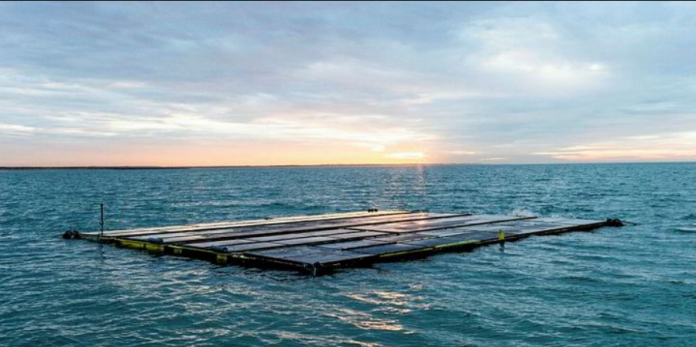A pioneering floating PV project installed in the Dutch North Sea late last year has ridden out its first months in open ocean, including the Ciara bomb cyclone, in a key test for a technology that has been calculated capable of one day supplying half of the Netherlands total energy demand.
Developer Oceans of Energy report the Zon-op-Zee (Solar-at-Sea) project, the world’s first offshore solar array, “remained stable and intact in all conditions” as it weathered winds of up to 62 knots and waves over five metres high.
The system, which has been designed to withstand the extremes of a North Sea environment, was doubled in size in January, from from 8.5kW to 17kW, with plans for the array to be expanded “further” in 2020, while continuing power production.
Oceans of Energy said it would “start publishing more operational results soon” for the potentially market-changing offshore energy concept.
“Clean energy generation without using land is needed, now and in the future,” said Oceans of Energy CEO Allard van Hoeken, when the Zon-op-Zee pilot was switched on in December.
“Our next aim is to expand to 1MW. The modular system is designed such that we can grow the installations towards 100MW and more. By having the first offshore solar system operational in one of the roughest seas in the world, we expect to create a large positive impact worldwide.”
Oceans of Energy calculate that offshore solar can supply “half of the Dutch total energy demand, while using less than 5% of the Dutch North Sea”, sea-space that the developer underlines can be found “within existing and planned offshore wind farms”.
“Offshore solar offers great advantages when using the same sea area as offshore wind farms. When solar modules float in the space between the turbine foundations, five times more energy is generated at the same area of sea,” said Van Hoeken.
The developer sees further synergies from the “collective use of components such as the grid connection to land, maintenance and installation works”, as offshore PV – which is sometimes referred to as “high wave solar” – drops to a levellised cost of energy matching offshore wind, that is, around €50/MWh ($55/MWh).
Zon-op-Zee was launched in 2017 by Oceans of Energy along with compatriot companies and research organisations TNO, MARIN and ONE-Dyas, with backing from Dutch enterprise agency Rijksdienst voor Ondernemend Nederland under the country’s Ministry of Economic Affairs and Climate’s so-called ‘Topsector Energie’ scheme.
In July, a consortium led by maritime contracting giant DEME launched an innovative €2m project to develop an open-ocean floating solar array concept off Belgium, as part of longer-term plans to build the technology into future offshore wind and aquaculture farms.
Though high-wave solar remains an emerging technology, in-land arrays are being seen as an increasingly attractive option for large-scale PV deployment on reservoirs and alongside hydropower facilities, especially where land is limited.
The largest such project currently is a 150MW development in Anhui, China, but, as Recharge has reported, that is soon set to be overshadowed by massive developments elsewhere in the world, including a 1GW plant in India and an sprawling 2.9GW complex off South Korea.
The world largest floating solar array outside China – BayWa’s 27.4MW Bomhofsplas project in the Netherlands – is slated to be up and running later this month, according to its developer.






